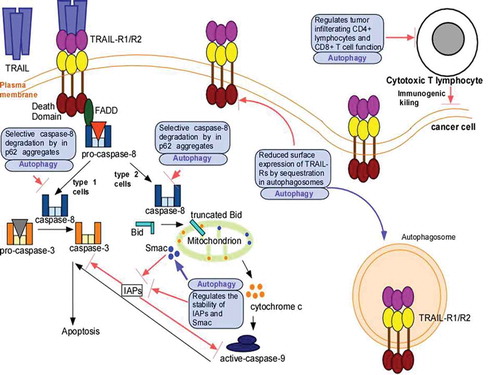Figures & data
Figure 1. Mechanism(s) by which autophagy confers Apo2L/TRAIL resistance. Apo2L/TRAIL-binding to its receptors TRAIL-R1 and -R2 recruits FADD via homotypic interactions between the death domains of FADD and TRAIL-R which, in turn, converts pro-caspase-8 into active caspase-8. In ype 1 cells, caspase-8 directly cleaves pro-caspase-3 and this leads to apoptotic cell death. In type 2 cells, caspase-8 cleaves Bid to form truncated Bid, which associates with mitochondria and leads to release of cytochrome c and Smac. The cytochrome c release activates pro-caspase-9 to form caspase-9, which, in turn, ultimately leads to pro-caspase-3 cleavage and apoptotic cell death. Inhibitors of apoptosis (IAPs) inhibit caspase-9 and caspase-3, and antagonize apoptosis. Smac inhibits IAPs and favors cell death. Autophagy promotes Apo2L/TRAIL resistance by interfering with its apoptotic signaling in various ways such as: degradation of caspase-8, decrease in surface expression of TRAIL-Rs by autophagic degradation, and decrease in the levels of Smac and increasing that of IAPs. Autophagy can also suppress immunogenic killing by regulating T-cell recruitment and function.

